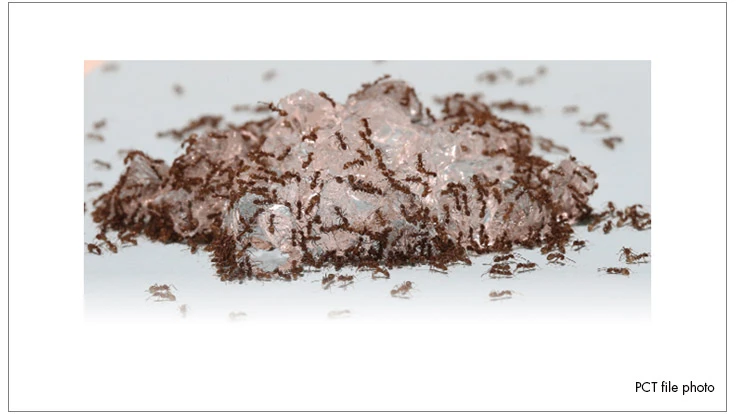
A team of researchers from the United States Department of Agriculture’s Agricultural Research Service is conducting experiments on a new water-resistant bait that has been showing promise, ESA reported.
Baits for fire ants have mostly gone unchanged since they were first developed in the 1960s — half a century ago — despite the significant drawback that the typical bait carrier breaks down in wet conditions. However, a new ant bait formulation that is water-resistant offers promise, say USDA-ARS researchers. Their comparison study is published in the Journal of Economic Entomology.
The USDA team conducted an experiment that deployed existing ant baits and water-resistant baits in closely matched wet conditions. Both baits carry an active ingredient that inhibits the ability of an ant colony’s queen to produce eggs. At the end of the 13-week test period, half of the red imported fire ant colonies exposed to standard bait were no longer producing worker ants, while none of the colonies exposed to the water-resistant bait were producing workers.
USDA’s Robert Vander Meer says the experiment was designed carefully to ensure that similar-sized ant colonies were compared and that they were exposed to baits under the same moisture and temperature conditions. “If you’re comparing two formulations of the same insecticide, at the same rates, then you have to control variables as much as you can, or else you’re not going to be able to show significant differences between the two,” he says. “We were very happily surprised.”
The water-resistant, or hydrophobic, ant bait, Erasant, is produced in Taiwan, by Chung Hsi Chemical Plant Ltd. The company has a U.S. patent, but the bait is not currently available in the United States.
Latest from Pest Control Technology
- Wildlife Operators Living Fund Supports Injured, Disabled PCOs and Wildlife Operators
- California Declares State of Emergency in Response to Bird Flu Outbreak
- Veseris Expands in Turf & Ornamental and Pool Supply with Acquisition
- Pest Authority, Mosquito Authority Celebrate All-Star Franchisees
- Ka Tsu Joins Avoca.ai
- Envu's Suite of Pest Management Solutions
- In Memoriam: Tom Moore
- 2024 Crown Leadership Award Winner Kathy Heinsohn





